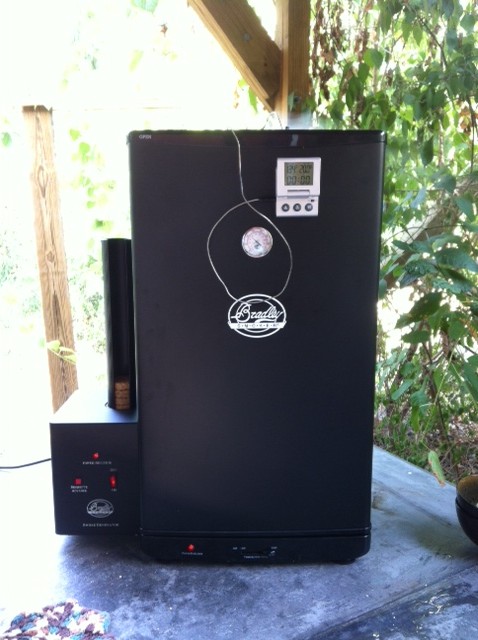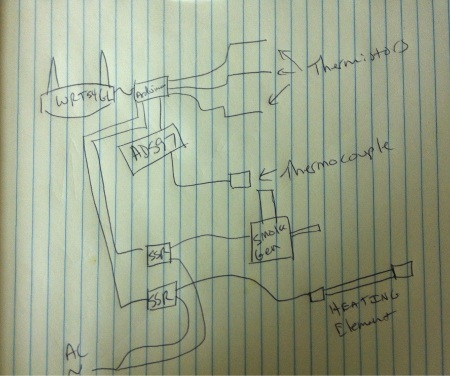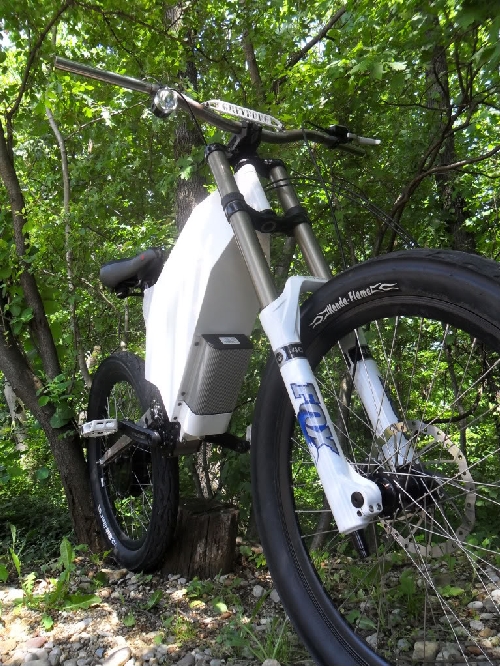So it begins. I’ve acquired a Bradley Smoker.

This particular unit is an interesting beast. It’s essentially a mini-fridge chassis (built for heat rather than cold). Up top is a standard grill smoke release hole, in the bottom is a undersized 500 watt heating element. Mounted on the side is the ‘Bradley smoke generator’. The smoke generator is actually very effective. A simple motorized slider delivers a preformed puck to a small hot plate. Once a puck is used up (timer based) it’s pushed off the hot plate by a replacement puck. The previous puck’s carcass is dropped neatly into a bowl of water – keeping the puck from reducing to ash. The heater control is pretty lame. If you’re not a modder, then consider the higher end digital controlled bradleys. They’re not much more online and look very nice. But we’re not here to talk about that…
So, I took a look at existing mods and quickly identified the primary needs.
1) Not enough heat. There’s enough coming off that element to make it work and keep people from burning their food. However, it’ll really suck to try to use on a cold/windy day. So, either add an additional heating element or a full on 900 watt element.
2) Temperature control – Adding a PID controller with SSR is the preferred method. Same tech I use on my espresso machine. Thermistors are a nice option – low component count.
3) Monitoring – We don’t want to open that thing very often. More information is better! Wifi and perhaps a custom rolled iphone app. I’ll use a pre-existing project as a base and tweak it for my needs.
4) Smoke control – I managed to over smoke some meats right out of the gate. They came out ok with some sauces, but I’m going to need the ability to dial it down. (Smoke for 3 hours, then cook for the finish…)
Parts list for this adventure:

Linksys WRT54GL – The linux modder friendly platform – with two ttl serial ports onboard, customizable linux distros for it and an existing project: Linkmeter – bbq monitoring platform.
Arduino – yeah yeah, it’s quick and reliable. I’ll develop with a full on device and swap in a boarduino for efficiency after the fact.
Maverick ET-72 replacement probes These are thermisters in a nice food save enclosure. We’ll use them to monitor internal temps of food.
K-Type Thermocouple – We’ll use this to monitor the smoker temperature and use it to determine when to drive the heating element. This is a very effective method – it’s worked on my espresso machine for the last two years without failure.
Solid State Relays – A pair of these will allow the Arduino/router to control both the heating elements and the smoke generator. Yes, we could even smoke a bit, cook for a bit, then smoke for a bit.
Additional parts will be used of course, but I’ll raid those from my standard stock. Oh, that includs a AD595 chip for reading the temp of the thermocouple. There are nicer newer chips, but it’s reliable and through hole mount. And I’ve already got it.
The basic design is here:

And a few more resources:
Here’s a similar project, but stand alone (no router)






